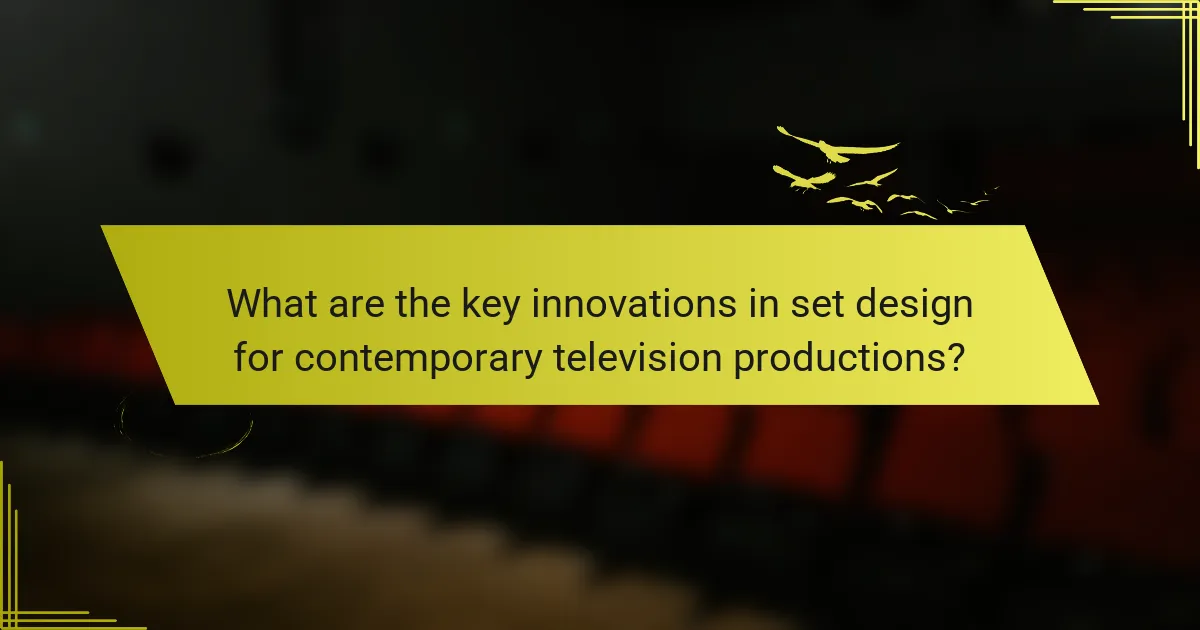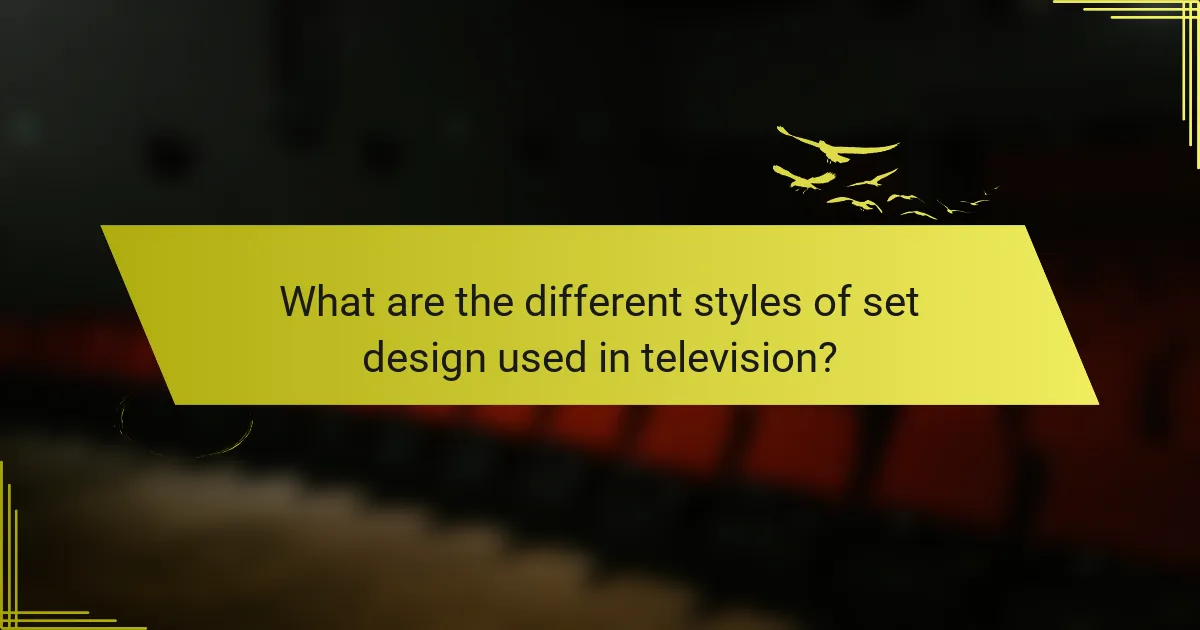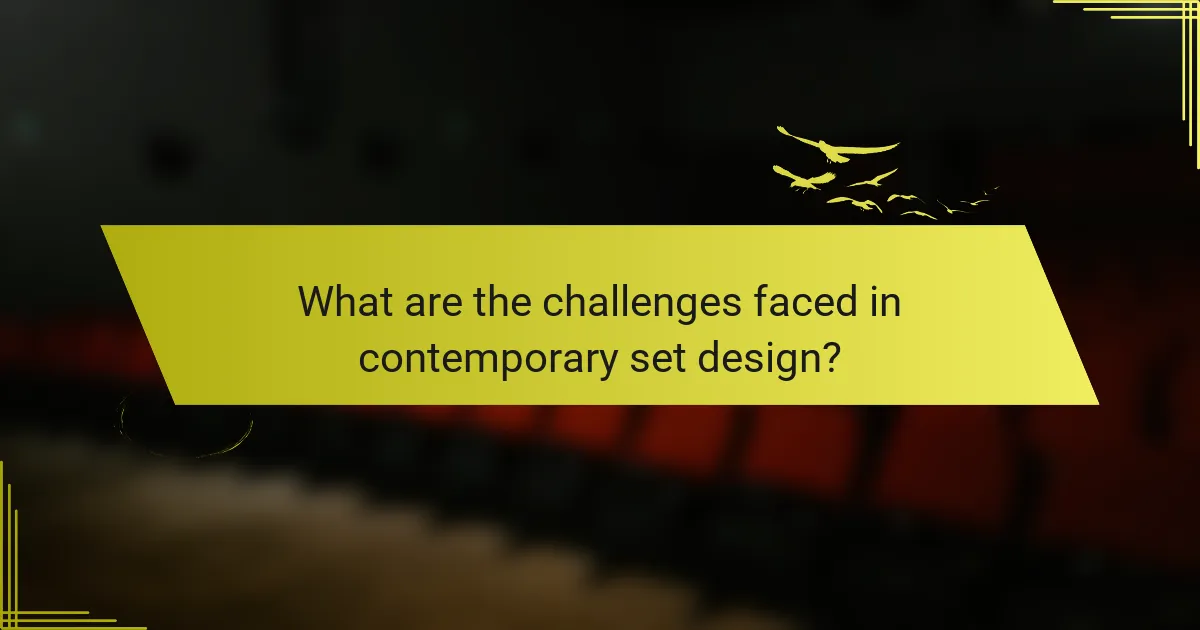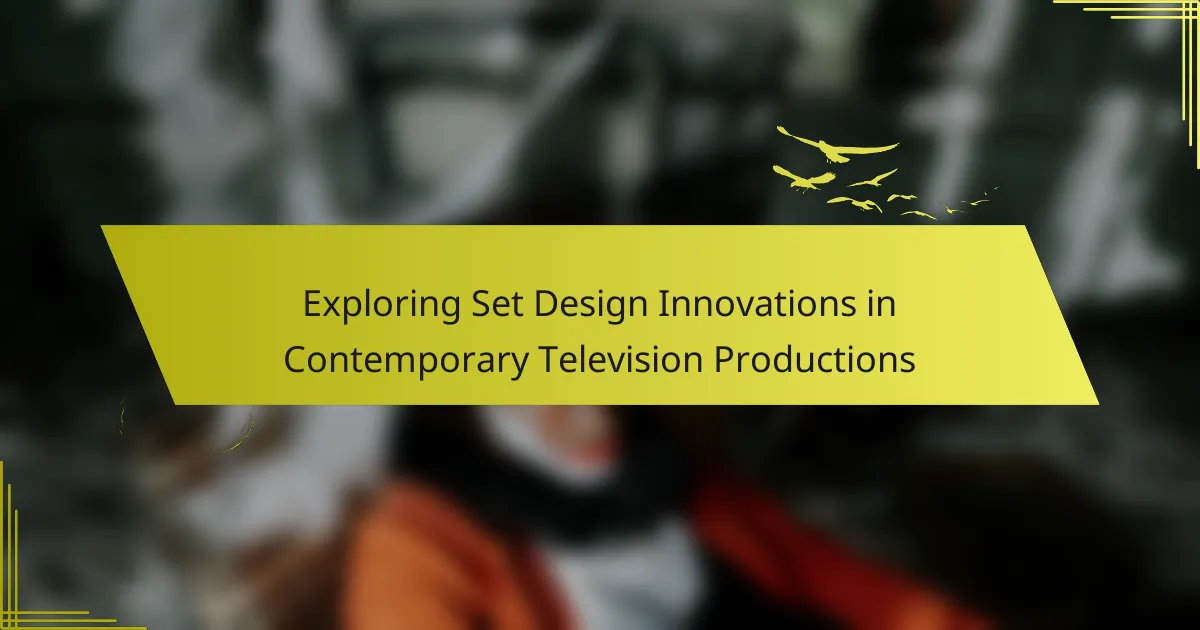Set design innovations in contemporary television productions are primarily characterized by the integration of virtual reality (VR) and augmented reality (AR) technologies, which facilitate immersive environments and real-time manipulation. Notable examples include the use of LED screens for dynamic backgrounds in shows like “The Mandalorian,” enhancing visual storytelling. Additionally, modular set designs, sustainable materials, and advances in 3D printing contribute to improved production efficiency and reduced environmental impact. The article also addresses various set design styles, including realism, minimalism, and stylization, each serving distinct narrative purposes. Furthermore, it highlights challenges faced by contemporary set designers, such as budget constraints, rapid technological changes, and the need for effective collaboration among production teams.

What are the key innovations in set design for contemporary television productions?
Key innovations in set design for contemporary television productions include the use of virtual reality (VR) and augmented reality (AR) technologies. These technologies allow for immersive environments that can be manipulated in real-time. For example, shows like “The Mandalorian” utilize LED screens for dynamic backgrounds, enhancing visual storytelling. Additionally, modular set designs enable quick reconfiguration for different scenes, improving production efficiency. Sustainable materials are increasingly used in set construction, reducing environmental impact. Advances in 3D printing also allow for rapid prototyping of intricate set pieces. Finally, integration of smart technology facilitates interactive elements, engaging viewers in new ways.
How have technological advancements influenced set design?
Technological advancements have significantly influenced set design by enhancing creativity and efficiency. Digital tools allow designers to create detailed virtual models before physical construction. These tools include 3D modeling software and virtual reality, enabling immersive previews of set designs. LED technology has transformed lighting, offering flexibility and energy efficiency. This allows for dynamic lighting changes that enhance storytelling. Automation in set construction has streamlined processes, reducing time and labor costs. Additionally, projection mapping technology enables the creation of elaborate backgrounds without physical sets. These advancements have elevated the visual quality of productions, making them more engaging for audiences.
What specific technologies are being utilized in modern set designs?
Modern set designs utilize several specific technologies. These include virtual reality (VR) for immersive environments. Augmented reality (AR) enhances physical sets with digital elements. LED screens provide dynamic backgrounds and lighting effects. 3D printing allows for customized set pieces. Motion capture technology aids in creating interactive elements. Advanced projection mapping transforms surfaces into animated displays. Computer-aided design (CAD) software streamlines the planning process. These technologies enhance creativity and efficiency in set design, allowing for more engaging viewer experiences.
How do these technologies enhance viewer experience?
Technologies enhance viewer experience by creating immersive environments. Advanced set design utilizes augmented reality, which blends digital elements with physical sets. This integration captivates audiences by adding depth and interactivity. High-definition visuals provide clearer images, improving overall engagement. Surround sound systems create a more realistic auditory experience. Enhanced lighting techniques evoke emotions and highlight key moments. Interactive elements allow viewers to connect with the narrative in unique ways. Studies show that immersive experiences increase viewer retention and satisfaction.
What role does sustainability play in contemporary set design?
Sustainability plays a crucial role in contemporary set design by minimizing environmental impact. Designers increasingly use eco-friendly materials and practices. This shift reduces waste and promotes resource conservation. For example, many sets are constructed from recycled or repurposed materials. Additionally, energy-efficient lighting and technologies are commonly implemented. According to a 2021 report by the Green Production Guide, sustainable practices can reduce a production’s carbon footprint by up to 30%. This growing emphasis on sustainability aligns with wider industry trends towards environmental responsibility. Thus, sustainability is integral to modern set design, influencing choices and practices.
How are productions integrating eco-friendly materials?
Productions are integrating eco-friendly materials by utilizing sustainable resources in set design. They are increasingly opting for recycled and biodegradable materials. This includes using reclaimed wood, recycled plastics, and organic textiles. Many productions are also sourcing local materials to reduce transportation emissions. Additionally, some sets are designed for reuse in future projects. This approach minimizes waste and promotes sustainability in the industry. According to a 2021 report by the Green Production Guide, 70% of productions are now considering environmental impact in their material choices.
What are the benefits of sustainable set design practices?
Sustainable set design practices reduce environmental impact and promote resource efficiency. They utilize eco-friendly materials, minimizing waste during production. These practices often lower costs by reusing and recycling set elements. Implementing sustainable designs can enhance a production’s reputation, attracting environmentally conscious audiences. According to a study by the International Alliance of Theatrical Stage Employees, sustainable practices can reduce carbon footprints by up to 30%. Additionally, they encourage innovation in design techniques and materials. This shift fosters a culture of sustainability within the industry, influencing future productions.
How do cultural trends impact set design choices?
Cultural trends significantly influence set design choices in television productions. Designers often reflect contemporary societal values and aesthetics in their work. For example, the rise of minimalism in lifestyle has led to simpler, more functional set designs. This trend emphasizes clean lines and open spaces, mirroring audience preferences for less clutter. Additionally, cultural movements, such as sustainability, have prompted the use of eco-friendly materials in set construction.
Historical context supports this; during the 1960s, sets often mirrored the vibrant colors and patterns of the pop culture movement. In contrast, the 2020s have seen a shift towards neutral palettes and natural elements. This change aligns with a growing awareness of mental health and wellness. Furthermore, the popularity of diverse storytelling has led to the incorporation of culturally specific elements in set design. This helps create authenticity and relatability for various audience demographics. Thus, cultural trends play a crucial role in shaping the visual language of television sets.
What recent cultural movements have influenced set aesthetics?
Recent cultural movements that have influenced set aesthetics include minimalism, sustainability, and retro-futurism. Minimalism emphasizes simplicity and functionality in design. This movement has led to cleaner lines and less cluttered spaces in set design. Sustainability focuses on eco-friendly materials and practices. Designers incorporate recycled materials and energy-efficient lighting to create sets. Retro-futurism draws inspiration from past visions of the future. This results in vibrant colors and imaginative shapes in contemporary sets. These movements reflect broader societal values and trends in design. They shape how audiences perceive and interact with television productions.
How do set designs reflect societal values and themes?
Set designs reflect societal values and themes by visually representing cultural norms and beliefs. They serve as a backdrop that communicates the story’s context. For example, a minimalist set may indicate modernity and simplicity, aligning with contemporary values of sustainability. Conversely, elaborate and ornate designs can signify wealth and tradition, showcasing historical values.
Research indicates that set design influences audience perception and emotional response. The use of color, space, and props can evoke specific feelings and reinforce thematic elements. A study by the University of Southern California found that viewers often interpret set design as a reflection of the characters’ social status and personality traits.
In summary, set designs are integral to storytelling in television. They encapsulate and convey the societal values and themes relevant to the narrative.

What are the different styles of set design used in television?
There are several styles of set design used in television. These styles include realism, minimalism, and stylization. Realism aims to create lifelike environments that reflect the real world. This style often involves detailed props and accurate representations of locations. Minimalism focuses on simplicity and functionality. It utilizes fewer elements to convey a scene effectively. Stylization emphasizes artistic interpretation over realism. This style often includes exaggerated features and imaginative designs. Each style serves different narrative purposes in television productions.
What are the characteristics of minimalist set design?
Minimalist set design is characterized by simplicity and functionality. It often features clean lines and a limited color palette. The use of negative space is a key element, allowing for focus on the action. Props and furniture are kept to a minimum, enhancing clarity. Lighting plays a crucial role in creating mood without clutter. This design approach encourages the audience’s imagination. Minimalist set design has roots in modern art movements. It promotes efficient storytelling by removing distractions.
How does minimalist design affect storytelling in television?
Minimalist design enhances storytelling in television by focusing on essential elements. It eliminates distractions, allowing viewers to engage deeply with characters and plot. This design approach emphasizes emotional resonance through simplicity. For example, shows like “The Leftovers” utilize sparse settings to amplify themes of loss and isolation. Research indicates that minimalist aesthetics can increase viewer immersion by reducing cognitive load. Consequently, audiences are more likely to connect with narrative nuances. Overall, minimalist design serves as a powerful tool for conveying complex stories effectively.
In what types of shows is minimalist design most effective?
Minimalist design is most effective in shows that prioritize storytelling and character development. This design approach enhances emotional engagement by eliminating distractions. Shows like “Breaking Bad” and “The Office” utilize minimalist sets to focus on narrative and character dynamics. Research indicates that minimalist design can improve viewer attention and retention. A study published in the Journal of Media Psychology found that simpler environments lead to better audience immersion. Therefore, minimalist design is particularly effective in drama and character-driven comedies.
What are the features of immersive set design?
Immersive set design features interactive elements that engage the audience. It utilizes three-dimensional spaces to create a realistic environment. Lighting plays a crucial role in setting the mood and enhancing the experience. High-quality props and materials contribute to authenticity. Sound design is integrated to provide an immersive auditory experience. Technology, such as augmented reality, is often employed to deepen engagement. The layout encourages audience movement and exploration within the space. Overall, these features work together to create a captivating and memorable experience for viewers.
How do immersive sets enhance audience engagement?
Immersive sets enhance audience engagement by creating a more interactive and visually stimulating environment. They allow viewers to feel as if they are part of the story. This sense of presence increases emotional investment in the narrative. Research shows that immersive environments can lead to higher levels of enjoyment and connection with the content. According to a study by the University of Southern California, immersive storytelling can increase viewer retention by up to 30%. This engagement is further fueled by the use of multi-sensory elements like sound and lighting. These factors work together to create a captivating experience that holds the audience’s attention.
What examples of immersive set design can be found in popular shows?
“Game of Thrones” features immersive set design with its detailed replicas of medieval castles and landscapes. The show’s production utilized real locations and built extensive sets to create the fictional world of Westeros. “Stranger Things” employs immersive set design through its recreation of the 1980s, including authentic props and decor that enhance the nostalgic atmosphere. “The Mandalorian” showcases groundbreaking immersive set design with the use of the Stagecraft technology, allowing for dynamic backgrounds that respond to lighting changes. “The Crown” offers an immersive experience with its historically accurate sets, reflecting the opulence of the British monarchy. “Westworld” utilizes expansive outdoor sets and intricate interiors to create a believable, futuristic theme park environment. Each of these shows demonstrates how immersive set design can enhance storytelling and viewer engagement.
What traditional set design elements are still relevant today?
Traditional set design elements still relevant today include realistic props, detailed backdrops, and spatial arrangement. Realistic props enhance authenticity in storytelling. Detailed backdrops provide context and atmosphere for the narrative. Spatial arrangement influences actor movement and audience perception. These elements have historical significance in theater and television. Their continued use demonstrates a commitment to immersive experiences. Research shows that realistic environments improve viewer engagement. The combination of these elements creates a cohesive visual narrative.
How do classic design elements blend with modern innovations?
Classic design elements blend with modern innovations through the integration of traditional aesthetics with contemporary materials and technology. This approach enhances visual storytelling by creating a familiar yet fresh environment. For instance, vintage furniture is often paired with sleek, modern lighting to create contrast. Additionally, color palettes may combine classic hues with modern finishes, resulting in a harmonious look.
Historical references are frequently incorporated into set designs, maintaining cultural significance while appealing to modern audiences. The use of advanced technologies, such as LED screens, allows for dynamic backgrounds that complement classic motifs. This combination not only preserves the essence of classic design but also elevates it through innovation.
Research indicates that blending these elements can improve audience engagement by evoking nostalgia while presenting a modern context. Therefore, the fusion of classic and modern design elements is a strategic choice in contemporary television set design.
What are the advantages of incorporating traditional elements in new productions?
Incorporating traditional elements in new productions enhances authenticity and cultural relevance. Traditional elements connect audiences to historical contexts and shared cultural narratives. They provide a sense of familiarity, which can evoke emotional responses. This connection can lead to increased viewer engagement and satisfaction. Research indicates that productions rooted in tradition often achieve higher critical acclaim. For instance, shows that integrate cultural motifs or historical accuracy frequently receive awards for set design. Traditional elements also offer unique aesthetic qualities that can differentiate a production in a competitive market. Overall, blending the old with the new enriches storytelling and visual appeal.

What are the challenges faced in contemporary set design?
Contemporary set design faces several significant challenges. Budget constraints often limit the resources available for materials and labor. Designers must balance creativity with cost-effectiveness. Additionally, rapid technological advancements require constant adaptation. Set designers need to integrate new technologies like virtual reality and augmented reality. Sustainability is another pressing concern in contemporary set design. Eco-friendly materials and practices are increasingly demanded. Furthermore, tight production schedules can hinder the design process. Designers must work efficiently to meet deadlines without sacrificing quality. Collaboration among various departments also poses challenges. Effective communication is vital to ensure a cohesive vision across the production team.
How do budget constraints affect set design choices?
Budget constraints significantly limit set design choices. Designers must prioritize essential elements over extravagant features. Limited funds often lead to the use of cheaper materials. This affects the overall aesthetic and quality of the set. Designers may opt for versatile designs that can be reused or adapted. Cost-effective solutions often include digital backdrops instead of physical sets. Additionally, budget limitations can reduce the number of set pieces or props. Ultimately, these constraints shape the creative process and final output in television productions.
What strategies can be employed to optimize set design within a budget?
Employing effective strategies can significantly optimize set design within a budget. First, prioritize essential elements and focus on key visual aspects. This approach ensures that the most impactful features are highlighted. Second, utilize modular design techniques. Modular designs allow for flexibility and reuse of components across different sets. Third, source materials locally to reduce transportation costs. Local sourcing can also support community businesses. Fourth, collaborate with students or emerging designers. This can provide fresh ideas at a lower cost. Fifth, leverage digital technology. Virtual sets can reduce physical material expenses and enhance creative possibilities. Lastly, implement a detailed budget plan. A clear financial outline helps track expenses and avoid overspending. These strategies have been successfully utilized in various productions, demonstrating their effectiveness in achieving high-quality designs within financial constraints.
How do financial limitations impact creativity in set design?
Financial limitations significantly restrict creativity in set design. Budget constraints often lead to simplified designs and fewer resources. Designers may have to prioritize essential elements over artistic expression. This can result in less elaborate sets that do not fully realize the creative vision. Limited funds can also restrict the use of high-quality materials and technology. Consequently, innovative techniques may be overlooked due to cost concerns. Ultimately, financial limitations can stifle the potential for unique and imaginative set designs.
What logistical challenges arise during set construction and design?
Logistical challenges during set construction and design include coordination of materials, scheduling conflicts, and space limitations. Coordinating materials requires timely delivery to avoid delays. Scheduling conflicts can arise between different departments, impacting the workflow. Space limitations often restrict the size and scope of the set. Additionally, safety regulations must be adhered to, complicating the construction process. Weather conditions can also affect outdoor set builds, leading to further delays. These challenges necessitate careful planning and communication among team members to ensure a successful production.
How can productions effectively manage time constraints in set design?
Productions can effectively manage time constraints in set design by implementing efficient planning and communication strategies. Establishing a clear timeline is essential for coordinating tasks. Utilizing modular set components can streamline the construction process. Collaboration between designers and builders minimizes delays. Regular progress meetings ensure that all team members are aligned. Utilizing digital tools for visualization can expedite decision-making. Prioritizing essential elements allows for a focus on critical aspects of the design. Historical data shows that productions that adopt these practices experience up to 30% reduction in set construction time.
What are common issues faced during set installation and breakdown?
Common issues faced during set installation and breakdown include logistical challenges, time constraints, and equipment malfunctions. Logistical challenges arise from coordinating multiple teams and resources. Time constraints can lead to rushed installations, affecting quality. Equipment malfunctions may disrupt the setup process, causing delays. Safety hazards can also occur, particularly in complex installations. Communication breakdowns among crew members can exacerbate these issues. Additionally, unexpected changes in design can complicate both installation and breakdown. These factors collectively impact the efficiency and effectiveness of set installation and breakdown in television productions.
What best practices can enhance the set design process?
Best practices that can enhance the set design process include thorough pre-production planning, effective collaboration among team members, and continuous iteration based on feedback. Pre-production planning allows for a clear vision and understanding of the project’s requirements. Collaboration fosters creativity and ensures that all aspects of the set are cohesive. Iteration based on feedback helps in refining designs and addressing any practical challenges. Research from the American Society of Interior Designers indicates that effective teamwork significantly improves project outcomes. Implementing these practices can lead to more innovative and functional set designs in contemporary television productions.
Set design innovations in contemporary television productions involve the integration of advanced technologies such as virtual reality (VR), augmented reality (AR), and LED screens, which enhance visual storytelling and viewer engagement. The article explores how these innovations improve production efficiency and sustainability through the use of eco-friendly materials and modular designs. Additionally, it examines the impact of cultural trends on set aesthetics, the challenges faced by designers, and best practices for optimizing the set design process. Key themes include the balance between creativity and budget constraints, the significance of traditional design elements, and the role of immersive experiences in captivating audiences.




